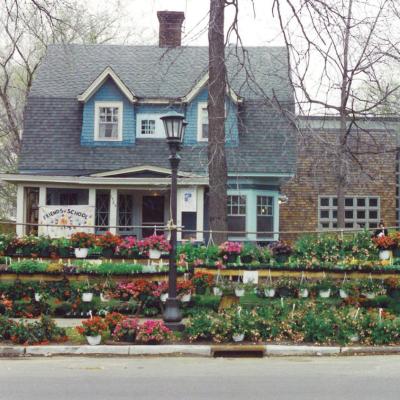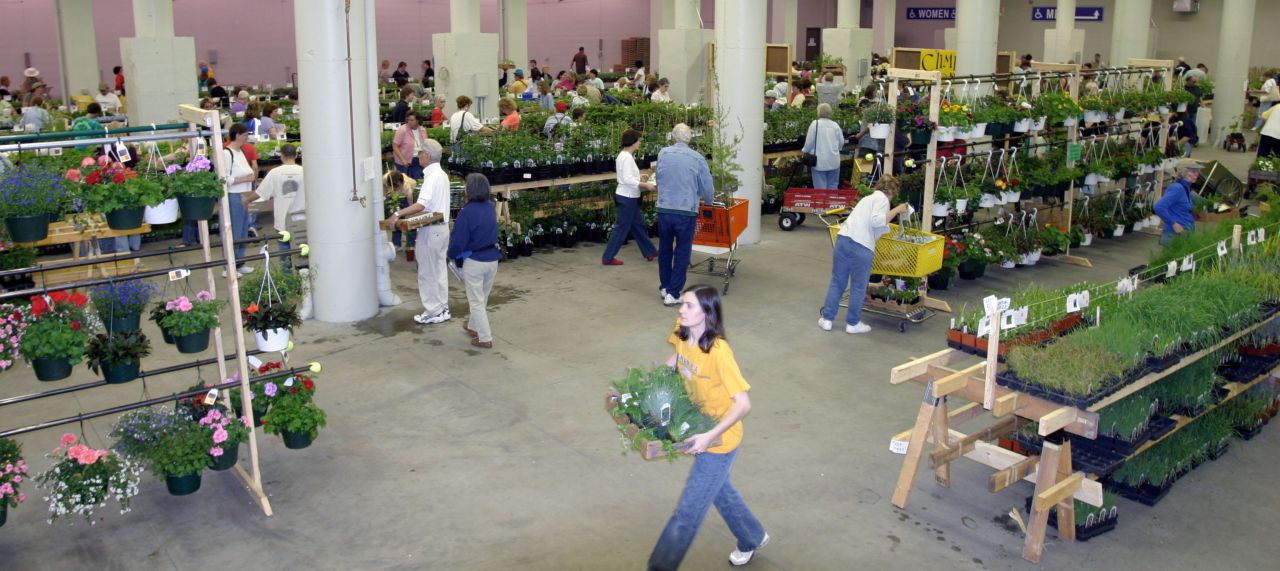Committed Volunteers … a Blooming Success
This article was originally written in May 2005, the year the plant sale moved from the Friends School grounds to the State Fair Grandstand.
For a timeline of plant sale "firsts," starting in 1988–89, check out this blog post from the sale's 30th anniversary in 2019.

Back in 1989, Henry Fieldseth never dreamed he’d be ordering over 2,200 varieties of plants for Friends School. He merely thought it was a good idea to help out with the first-ever plant sale at the small school his daughter attended. In that first year, if you came to FSM’s plant sale, you had only two hours to shop and only a handful of plants from which to choose. There were marigolds, impatiens, and unique 50-cent perennials from Green Fingers Farm.
The catalog, if it could be called such, was a single, photocopied page with no color or illustrations–quite a contrast to today’s gorgeous 60-page color catalog, chock-full of useful information for novice to experienced gardeners alike.
Henry quickly saw the potential success of a Friends School Plant Sale, particularly the strong interest in unique perennials at very reasonable prices. “Since the first year, Friends School began carrying a signature line of unique perennials that have been very good for us.” Henry has become the expert, as well as historian, for Friends School’s Plant Sale. He now works, as a volunteer, year-round on the sale. One can often find him in the front office at FSM, buried in piles of plant catalogs.
From one organizer to two
Early on, Henry discovered the importance of enlisting committed volunteers. One of his best recruits, Victoria (Toria) Erhart, began as a volunteer when her daughter Kate was at Friends School in the early 1990s. “What is remarkable about Toria is that she has become more involved after her child left the school, instead of less involved,” remarked Henry. Toria takes part in ordering, organizing and supervising the display of plants and figuring out what will go where and how many tables are needed. Toria’s paid vocation is as a family practice physician. She takes off a whole week of work for the plant sale.
So how do you take this great plant sale and grow it without losing the spirit of the school? How do you bring in more people with the skill set to run this volunteer event with business sense, but also a heart?
Growing the catalog
Enter super volunteer Pat Thompson. Pat first found the Plant Sale catalog at her daughter Ruby’s preschool in 1997 and thought it looked interesting. When she came to pick up her order at Friends School (this was still during the pre-ordering days) Pat saw Henry running around in the pouring rain, unloading a truck of plants. She was intrigued, thinking, “These people need help!”
The next year, Pat returned to the sale. She laughs when she thinks about her timing. “I did the ultimate silly thing, arriving at 11:10 on Friday morning, expecting to be able to get my plants, breeze through and make it downtown by 12:30. It was pouring rain, 45 degrees and I had no rain coat.” Although she then learned about the Friday morning plant sale craze, she met many nice staff and parents in line.
The plant sale was a major reason Pat became interested in FSM as the school for her daughter. “I could tell things about the school from the sale. Seeing the kids working made a big impression. It had a good feel. I like organizations where parents and kids are involved.”
The catalog was of particular interest to Pat. As an owner of a graphic design company, she knew improvements could be made. “I wanted to get my hands on the catalog. It caught my interest right away. It was good, but I knew it could be better and more effective.”
Pat now volunteers year-round on the plant sale. The plant sale committee is a strong community and also a group of friends. She and Tom Bolstad, another long-time, super volunteer, work on the database used to keep track of the plants. Tom has created a sophisticated database just for the plant sale that tracks inventory and now allows the committee to make better buying decisions.
“Some people go to another country to build houses as a volunteer ‘vacation,’ ” says Pat, “but I choose to stay closer to home, to make a difference in our community here. The plant sale is very concrete and satisfying. It’s the highlight of my year.”
Volunteers from beyond the school's community
In addition to Pat, Toria, and Henry, there are dozens more volunteers who take time off from work to make the plant sale happen. Over the years, gardeners from the community with no other connection to Friends School have also become core volunteers. Take Carol Herman for example. Carol, a garden enthusiast, started volunteering one shift a year in order to be able to shop early Thursday night. She found she couldn’t stay away and began adding shifts. Her knowledge of plants caught the committee’s eye, and Carol joined the buying committee. (The buying committee meets weekly for three to four hours a time, September-January, so this is no small commitment.)
At the sale in recent years, Carol had a permanent position at the Rare Plants table for the entire sale. More recently, she can be found at the Information Desk.
As the plant sale grew, the location at Friends School became more problematic. The school grounds were trampled, parking was scarce and then there was the weather. Plant sale weekend is traditionally known for its bad weather. 2004’s weather was no exception, when straight line winds blew the tents onto parked cars and forced volunteers inside for shelter. The damage cut into FSM’s profits and caused Henry to consider other options. He had investigated the State Fair in previous years, but now the time seemed right to take the risk and move.
The plant sale committee took a field trip to the State Fair Grandstand building in September of 2004. “There were many unanswered questions and it felt a bit scary, but it seemed like the right thing to do,” says Toria.
The move to the Grandstand
Some in the FSM community were skeptical about moving to the Grandstand. “I thought it would lose the flavor of the school and seem too commercial,” says Susan Nagel, parent and plant sale volunteer. “I couldn’t have been more wrong. The space was fantastic.”
The camaraderie and enthusiasm of the FSM volunteers has transcended location. The atmosphere was electric on the morning before the door opened at 11:00 the first year at the Grandstand. Middle school students, in their tie-dyed volunteer shirts, were busy checking last-minute details. With over 500 volunteer time slots to fill, coordinator Dhaivyd Hilgendorf had his hands full. The space was bigger, there were new challenges, but the plants arrived and so did the people. People come to the plant sale from all over, taking off work, coming with friends and turning it into a tradition. “My friends and I have been coming for years. We take off work, go out to an early breakfast to go through our catalog one last time, and then come shop,” said a woman named Trish while waiting in line.
“There’s a website called gardenweb.com that has a thread all about Friends School plant sale,” says Henry. “On the website, people said they have come from as far as Philadelphia for our sale. It’s become a big deal.”
On opening Friday in 2005, eighth graders counted 1,000 people waiting in the bright sunshine of a cloudless day. Toria, in her slightly faded pink hat, waited anxiously by the entrance. When she heard the news of the happy, excited crowd outside, she said, “This is really incredible. To see this sale come so far, and do so much for the school and our community, really warms my heart. It’s a bit like giving birth.”

When asked what the best thing is about the plant sale, Pat laughs. “Most importantly, it raises a bunch of money for Friends School. But for me the best thing is the people–I love the plant sale committee. To work with such a competent group of people, who are all volunteering their time for the same cause, is amazing. It’s energizing. It makes your life better.”
And thanks to Pat, Henry, Toria, and hundreds of other volunteers, the plant sale makes the lives of children at Friends School better, providing scholarships to make the school more accessible to everyone. Sixteen years ago, the $2,000 profit seemed like a good effort. But in recent years, Friends School is able to add the profit of nearly $200,000 to the scholarship fund.
—Wendy Lutter